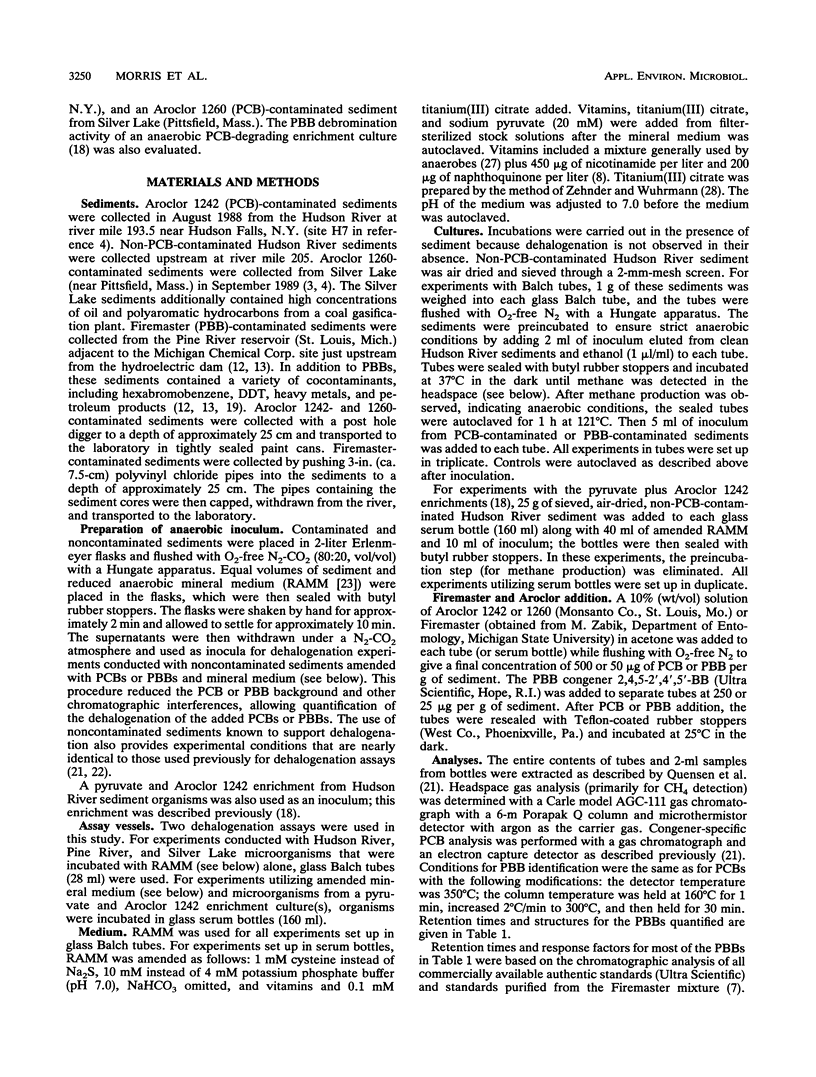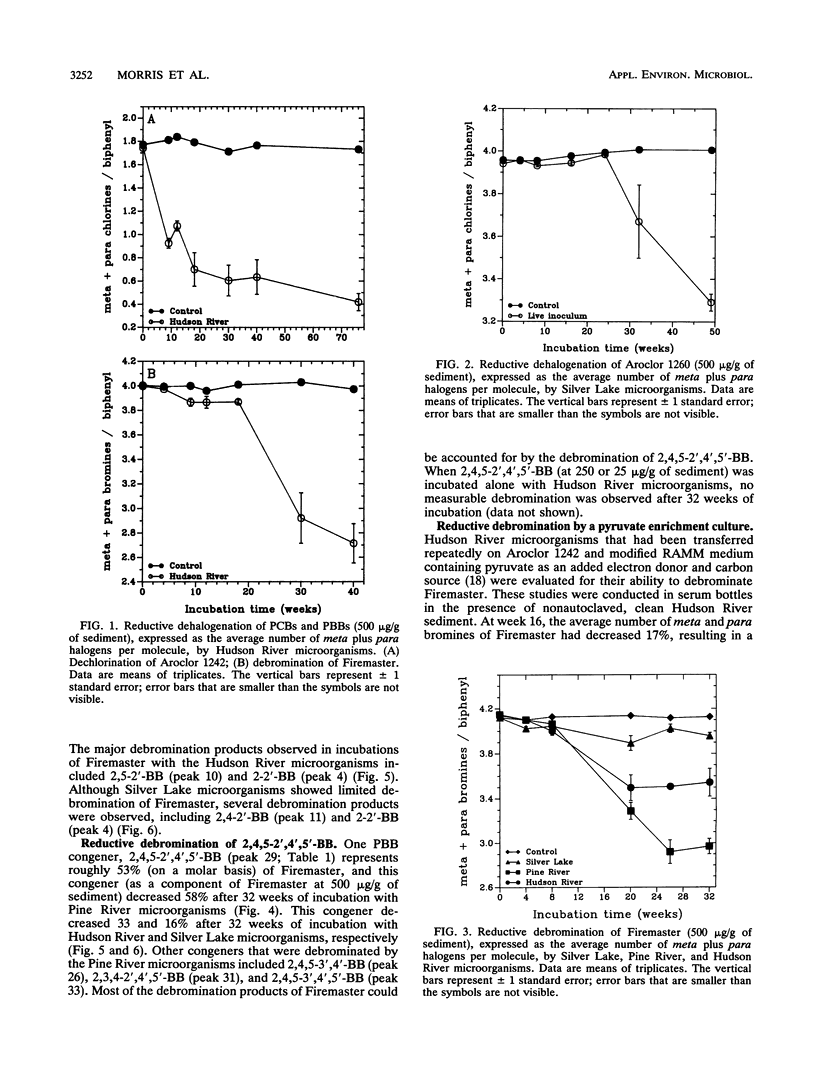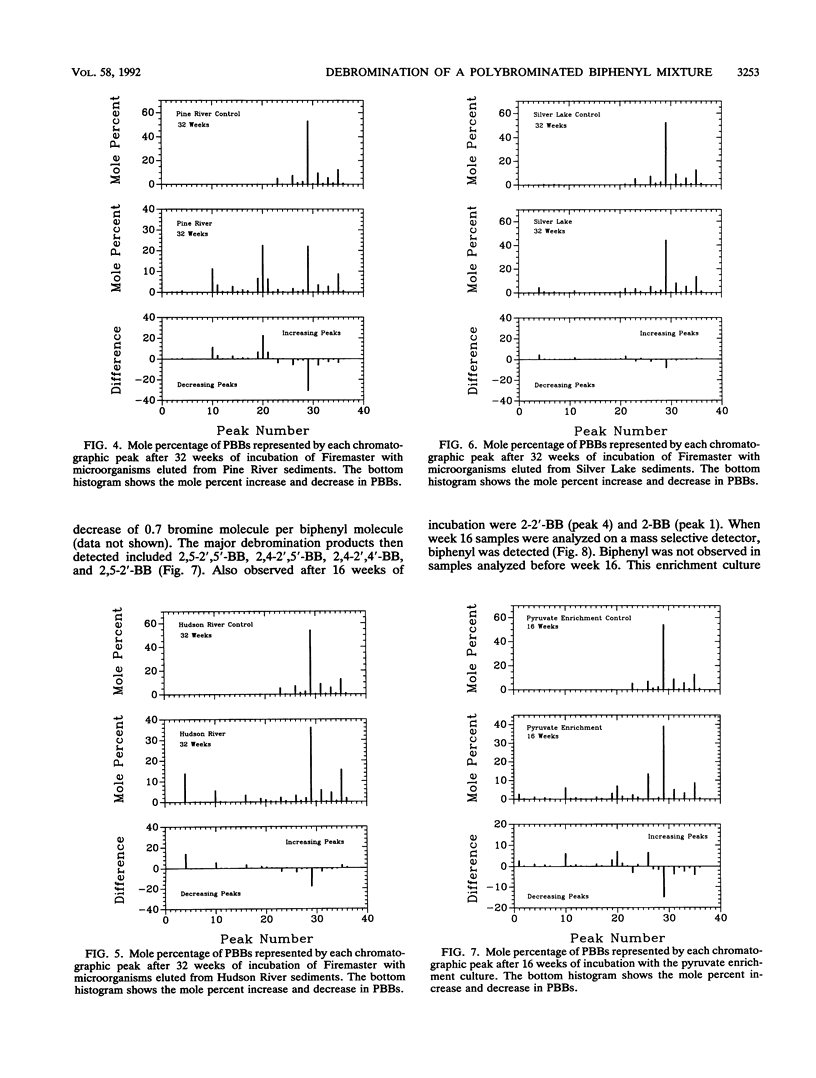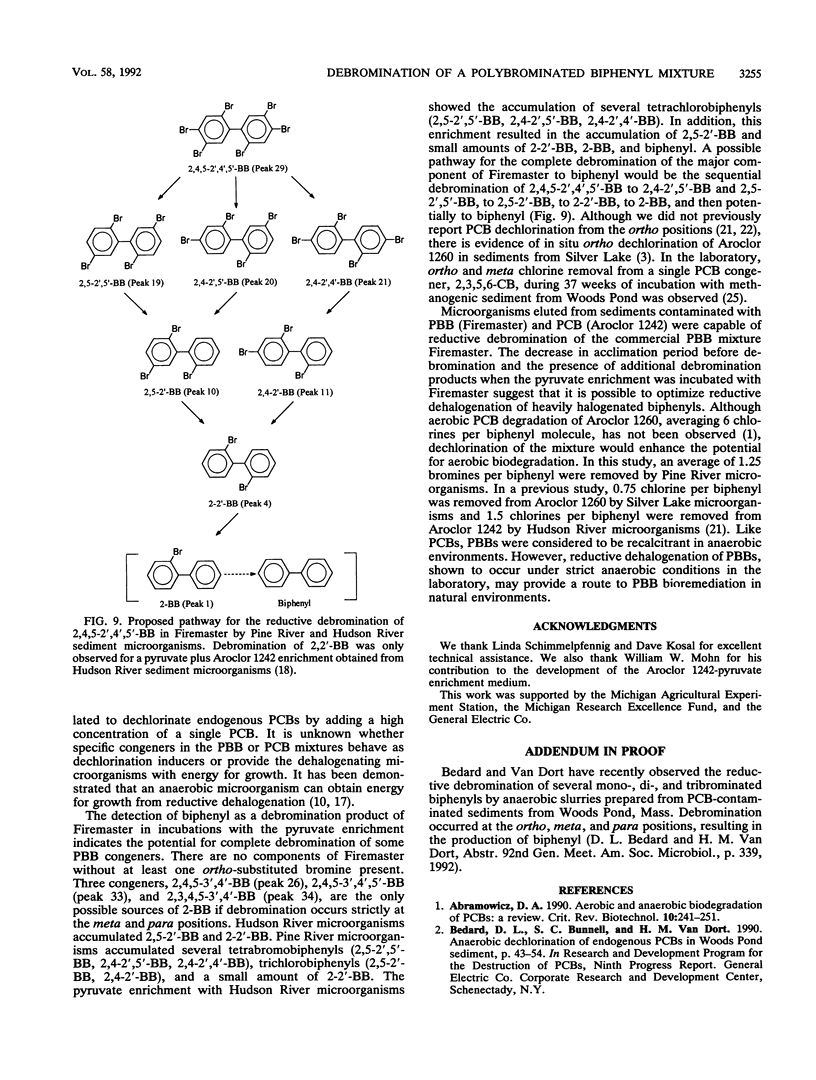Abstract
Anaerobic microorganisms eluted from three sediments, one contaminated with polybrominated biphenyls (PBBs) and two contaminated with polychlorinated biphenyls, were compared for their ability to debrominate the commercial PBB mixture Firemaster. These microorganisms were incubated with reduced anaerobic mineral medium and noncontaminated sediment amended with Firemaster. Firemaster averages six bromines per biphenyl molecule; four of the bromines are substituted in the meta or para position. The inocula from all three sources were able to debrominate the meta and para positions. Microorganisms from the Pine River (St. Louis, Mich.) contaminated with Firemaster, the Hudson River (Hudson Falls, N.Y.) contaminated with Aroclor 1242, and Silver Lake (Pittsfield, Mass.) contaminated with Aroclor 1260 removed 32, 12, and 3% of the meta plus para bromines, respectively, after 32 weeks of incubation. This suggests that previous environmental exposure to PBBs enhances the debromination capability of the sediment microbial community through selection for different strains of microorganisms. The Pine River inoculum removed an average of 1.25 bromines per biphenyl molecule during a 32-week incubation period, resulting in a mixture potentially more accessible to aerobic degradation processes. No ortho bromine removal was observed. However, when Firemaster was incubated with Hudson River microorganisms that had been repeatedly transferred on a pyruvate medium amended with Aroclor 1242, 17% of the meta and para bromines were removed after 16 weeks of incubation and additional debromination products, including 2-bromobiphenyl and biphenyl, were detected. This suggests the possibility for ortho debromination, since all components of the Firemaster mixture have at least one ortho-substituted bromine.(ABSTRACT TRUNCATED AT 250 WORDS)
Full text
PDF







Selected References
These references are in PubMed. This may not be the complete list of references from this article.
- Brown J. F., Jr, Bedard D. L., Brennan M. J., Carnahan J. C., Feng H., Wagner R. E. Polychlorinated biphenyl dechlorination in aquatic sediments. Science. 1987 May 8;236(4802):709–712. doi: 10.1126/science.236.4802.709. [DOI] [PubMed] [Google Scholar]
- Carter L. J. Michigan's PBB Incident: Chemical Mix-Up Leads to Disaster. Science. 1976 Apr 16;192(4236):240–243. doi: 10.1126/science.192.4236.240. [DOI] [PubMed] [Google Scholar]
- Chou S. F., Jacobs L. W., Penner D., Tiedje J. M. Absence of plant uptake and translocation of polybrominated biphenyls (PBBs). Environ Health Perspect. 1978 Apr;23:9–12. doi: 10.1289/ehp.78239. [DOI] [PMC free article] [PubMed] [Google Scholar]
- Dannan G. A., Mileski G. J., Aust S. D. Purification of polybrominated biphenyl congeners. J Toxicol Environ Health. 1982 Mar;9(3):423–438. doi: 10.1080/15287398209530175. [DOI] [PubMed] [Google Scholar]
- Di Carlo F. J., Seifter J., DeCarlo V. J. Assessment of the hazards of polybrominated biphenyls. Environ Health Perspect. 1978 Apr;23:351–365. doi: 10.1289/ehp.7823351. [DOI] [PMC free article] [PubMed] [Google Scholar]
- Dolfing J. Reductive dechlorination of 3-chlorobenzoate is coupled to ATP production and growth in an anaerobic bacterium, strain DCB-1. Arch Microbiol. 1990;153(3):264–266. doi: 10.1007/BF00249079. [DOI] [PubMed] [Google Scholar]
- Filonow A. B., Jacobs L. W., Mortland M. M. Fate of polybrominated biphenyls (PBB's) in soils. Retention of hexabromobiphenyl in four Michigan soils. J Agric Food Chem. 1976 Nov-Dec;24(6):1201–1204. doi: 10.1021/jf60208a004. [DOI] [PubMed] [Google Scholar]
- Jacobs L. W., Chou S. F., Tiedje J. M. Fate of polybrominated biphenyls (PBB's) in soils. Persistence and plant uptake. J Agric Food Chem. 1976 Nov-Dec;24(6):1198–1201. doi: 10.1021/jf60208a005. [DOI] [PubMed] [Google Scholar]
- Jacobs L. W., Chou S. F., Tiedje J. M. Field concentrations and persistence of polybrominated biphenyls in soils and solubility of PBB in natural waters. Environ Health Perspect. 1978 Apr;23:1–8. doi: 10.1289/ehp.78231. [DOI] [PMC free article] [PubMed] [Google Scholar]
- Mohn W. W., Tiedje J. M. Strain DCB-1 conserves energy for growth from reductive dechlorination coupled to formate oxidation. Arch Microbiol. 1990;153(3):267–271. doi: 10.1007/BF00249080. [DOI] [PubMed] [Google Scholar]
- Morris P. J., Mohn W. W., Quensen J. F., 3rd, Tiedje J. M., Boyd S. A. Establishment of polychlorinated biphenyl-degrading enrichment culture with predominantly meta dechlorination. Appl Environ Microbiol. 1992 Sep;58(9):3088–3094. doi: 10.1128/aem.58.9.3088-3094.1992. [DOI] [PMC free article] [PubMed] [Google Scholar]
- Quensen J. F., 3rd, Tiedje J. M., Boyd S. A. Reductive dechlorination of polychlorinated biphenyls by anaerobic microorganisms from sediments. Science. 1988 Nov 4;242(4879):752–754. doi: 10.1126/science.242.4879.752. [DOI] [PubMed] [Google Scholar]
- Quensen John F., Boyd Stephen A., Tiedje James M. Dechlorination of Four Commercial Polychlorinated Biphenyl Mixtures (Aroclors) by Anaerobic Microorganisms from Sediments. Appl Environ Microbiol. 1990 Aug;56(8):2360–2369. doi: 10.1128/aem.56.8.2360-2369.1990. [DOI] [PMC free article] [PubMed] [Google Scholar]
- Shelton D. R., Tiedje J. M. General method for determining anaerobic biodegradation potential. Appl Environ Microbiol. 1984 Apr;47(4):850–857. doi: 10.1128/aem.47.4.850-857.1984. [DOI] [PMC free article] [PubMed] [Google Scholar]
- Van Dort H. M., Bedard D. L. Reductive ortho and meta Dechlorination of a Polychlorinated Biphenyl Congener by Anaerobic Microorganisms. Appl Environ Microbiol. 1991 May;57(5):1576–1578. doi: 10.1128/aem.57.5.1576-1578.1991. [DOI] [PMC free article] [PubMed] [Google Scholar]
- WOLIN E. A., WOLIN M. J., WOLFE R. S. FORMATION OF METHANE BY BACTERIAL EXTRACTS. J Biol Chem. 1963 Aug;238:2882–2886. [PubMed] [Google Scholar]
- Zehnder A. J., Wuhrmann K. Titanium (III) citrate as a nontoxic oxidation-reduction buffering system for the culture of obligate anaerobes. Science. 1976 Dec 10;194(4270):1165–1166. doi: 10.1126/science.793008. [DOI] [PubMed] [Google Scholar]


